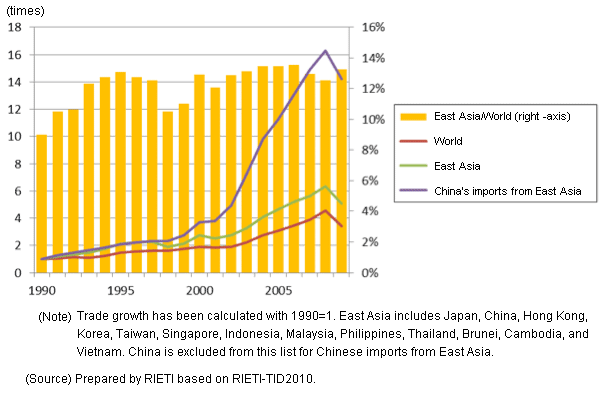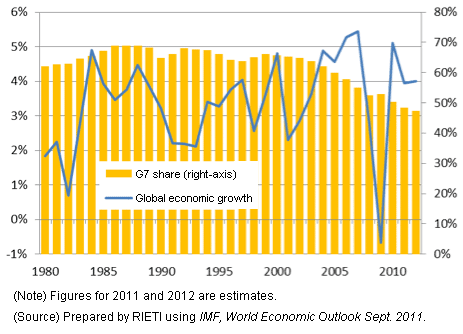Newly-developing nations are underpinning the global economy
With elements such as the mounting European debt crisis and economic deceleration of newly-developed countries in play, it is not easy to have an optimistic outlook towards the global economy in 2012. Still, certain major economies are indicating that they can go nowhere but up from here, and robust economic growth present in newly-developing countries, particularly Asia, will likely continue to underpin the global economy going forward.
Where the U.S. economy is concerned, given the high unemployment rate and low-level growth in income, it is difficult to conclude that the steady personal spending visible in the immediate term will persist. Meanwhile, adjustments to compensate for the monetary bubble precipitated largely by subprime loans continue forward. Although U.S. households exhibited a home ownership ratio that at one time peaked at 70% relative to historical levels hovering around 64%, this indicator has been in the process of returning to the 64% level in recent years, with a similar trend also visible in the disposable income to debt per household ratio. It goes without saying that a larger portion of household income is being diverted towards repayment efforts, and that portion is being reflected in curbed personal spending. The increase in personal spending responsible for the growth in the U.S. economy from 2001 through 2007 has been weak since 2008. This trend is likely to continue into 2012 as well, keeping the growth rate of the U.S. economy on the relatively low side. Naturally, this low level of growth is nonetheless occurring at a time when structural adjustments to its economy are being pushed forward, and as such, does not merit concern about dipping into recession once more.
In the Chinese economy as well, the rate of increase in consumer prices, which was in the range of 6%, had become a drag on that nation's high-level growth sustainability. However, this rate stagnated to below 4.5%, thereby causing the conditions for sustaining high-level growth to fall in place. Upon convening in December 2011, the National Economic Council, through which the Chinese Communist Party and national government set forth the economic policy for the following year, wasted no time in shifting from curbing prices to prioritizing growth. Judging from its past record of having its public finances propped up by the sales of land usage rights under the nation's system of government ownership of land, as well as its formidable ability to execute policy that allows the government to manage the capital expenditure of state-owned enterprises, the possibility that China will sustain its high-level economic growth in 2012 as well is high.
Similar to China, commensurate growth can also be expected of the principal nations of East Asia. It is evident that the economic deceleration is the result of credit squeezing and similar efforts implemented as a result of rising inflation in India and several other Asian countries. However, steady growth in personal spending stemming from higher income levels, coupled with the growth in capital expenditure founded in part on foreign capital inflows, is currently underpinning the economic growth of principal East Asian countries. Additionally, there is plenty of room for monetary and fiscal policy to play a potential role in shoring up economic conditions in these countries. Moreover, from around 2000 onwards, Chinese imports from East Asian countries, which are further solidifying their presence within the Asian economy, have been increasing rapidly. The growth rate of these imports, which, at 17.9% per annum following the turn of the century, greatly exceeds that of world trade as a whole, is also a contributor to the growth exhibited by the nations of East Asia (See Figure 1).

In Japan as well, solid economic growth is also anticipated due to a manifestation of recovery demand. Recovery efforts in the wake of the Great East Japan Earthquake are a top-priority issue, and there is much that needs to be done. Meanwhile, the supply chains damaged in the disaster are being steadily restored, and three national supplementary budgets, which are spread out over slightly more than 18 trillion yen, will act to push economic conditions upwards by close to 2% through fiscal 2012. Even should there be a weakening in exports due to a deceleration in the global economy, among major advanced powers, Japan is expected to demonstrate relatively favorable rates of economic growth.
Moving to deter further escalation of the European debt problem
The headlining cause for concern with regards to the global economy for 2012 is the European debt problem. Austerity measures being implemented to restore the budget to wholesome levels have created downwards pressure on the European economy, with Greece and other nations mired in a debt crisis requiring a significant degree of economic adjustment. As a side note, a look at Greece's savings-investment balance reveals that households as well as government sectors have consistently treaded a path towards becoming sizable entities of over-investment. As an example, the home loan balance for Greece from 2000 through 2009 ballooned 6.1 times over, a rate that largely exceeds that of Spain, whose housing bubble had burst, at 3.7. Like the public finance sector, the household sector in Greece can no longer avoid severe adjustments.
And yet, though growth in the European economy during 2012 may be stagnant with few signs on the horizon for a fundamental improvement in the European debt problem, a worsening of the situation is in the process of being prevented. For example, as long as fund procurement efforts by the governments of both Italy and Spain do not become completely disrupted, sufficient liquidity within the eurozone can remain secure. Funding assistance for nations in crisis by the European Financial Stability Facility (EFSF), International Monetary Fund (IMF), EU, and other institutions, as well as supplies of euros and dollars from the European Central Bank (ECB) and the central banks of six major powers, are ensuring that debt-crisis countries such as Greece and European financial institutions have cash flow. Additionally, a framework for compensating for the insufficient capital of financial institutions following the implementation of a stress test is currently in development.
Moreover, as shown at the EU summit meeting held last December, efforts to strengthen fiscal restraint in each EU nation are also underway. While some may tend to expect bolder measures, such as an amplified purchase of government bonds belonging to the debt-crisis nations within the region covered by the ECB, the primary duty that the ECB has been charged with rests in price stabilization. Bearing in mind the constraint that fiscal restrictions are not to be interfered with, amid the division of roles surrounding these efforts, the position of the ECB as a supplier of liquidity within the region and that of the governments of each EU nation as facilitators of preserving monetary systems and strengthening fiscal restraint represent quite a formidable safety net.
In the summer of 2012, the European version of the IMF, dubbed the European Stability Mechanism (ESM), is scheduled to be established. Even if this and the other aforementioned measures prove not to be a fundamental solution to the growth stagnation of the European economy and its debt problem, they are anticipated to curb effectively a further escalation of that problem.
Key to growth in advanced nations lies in innovation and deepened relations with newly-developing countries
As of September 2011, the IMF has issued a forecast of 4.0% for the rate of growth of the global economy in 2012 (See Figure 2). When compared to growth from the 1980s onward, this rate is by no means low, and in recent years has been driven by the advanced growth in China and other newly-developing countries. Accordingly, existing structural challenges for the global economy lie not in the economic crises and low growth levels being experienced by the world economy as a whole, but in the retarded growth levels of advanced nations. A look at the percentage of world GDP represented by the G7 powers also reveals that late 1980s levels, which approached 70%, contracted to as low as 44% by 2010 in the face of the high level growth demonstrated by the East Asian countries from 2000 onward, particularly that of China.

What has been made apparent by the financial bubble in the United States, the government debt problem in Europe, and needless to say the Japanese economy as well is that as lower birthrates and an aging population become increasingly prevalent in advanced nations, and newly-developed countries catch up with their advanced brethren through endeavoring towards increased industrialization, the ability to identify a desirable growth model for Japan, the United States, and major European powers is becoming increasingly nonexistent.
Currently, major advanced powers are focusing on economic adjustments to reconcile excessive fiscal deficits and financial bubbles. However, these adjustments, while absolutely necessary, do not automatically guarantee new high-level growth. The sole means of facilitating new growth without falling back on economic imbalance is to actualize corporate vitality. One may conclude, therefore, that large-scale innovation on the same level as that seen in the United States' dot-com bubble during the 1990s is necessary in order for advanced nations to realize favorable economic growth over the long term.
At the same time, in a global economy in which newly-developed countries continue to grow at elevated rates, it is also crucial for advanced nations to absorb this high-level growth to a greater degree than before. What that translates into is advanced nations deepening their trade and investment relations with newly-developing countries. Moreover, the deepening of such relations must be mutual in nature. In the past, from the perspective of developing countries, exports to advanced nations were a significant means of achieving economic growth. At present, a reverse scenario is in the process of coming about in which advanced nations conduct exports to newly-developing nations and benefit from direct investment from vibrant enterprises based in those nations. This, in turn, is gradually becoming a significant means of achieving economic growth for advanced nations.
Economic recovery in advanced nations as an issue within the greater world economy will carry over from 2011 to 2012. Moreover, as the global economy undergoes a structural shift, advanced nations will require a major transformation in order to rebuild fundamentally their economies. Japan and other major advanced powers can only hope that 2012 will bear witness to large-scale structural changes in the economy and industry.

